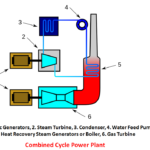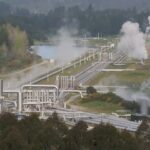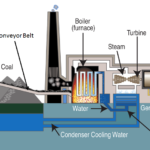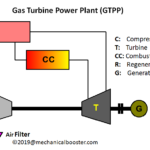Introduction
People are using the energy of flowing water from thousands of years, and today it is the most powerful source of clean, renewable, and most affordable energy. America is been using this energy for over a hundred years for now. And what makes this source renewable is the water, water evaporates back to the cloud and falls back to earth as rain completing the water-cycle and making it a noble source of energy to be used over and over again. It holds the largest share in worldwide electricity production from renewable sources of energy. And the basic idea is water flows from a higher elevation to low elevation making the turbines to rotate and this rotational motion is used to generate electricity through generators in hydropower plant stations.
India’s Hydro Potential
As of 30th, April 2017, India holds seventh position all over the world in generating power from water. India’s potential of generating electricity is estimated as 84,000 MW at 60% of load factor .Taking about year 2016-17; India has produced 122.31 TWh (terawatt hours) of electricity from water, that too at an average capacity factor of 33%.
The projects of hydro power that hold a great power potential but yet not developed due to opposition of some local people are on Godavari, Mahanadi, Nagavali, Namsadhara and Narmada river basins.
India’s largest electricity producing hydropower plant is on Koyna river in Maharastra having a capacity of producing 1920MW of electricity.
Bhagra Nagal dam in India is the world’s highest straight gravity dam and biggest of all dams in India.
Working Principle
The potential energy of stored water is converted into kinetic energy and is utilized to rotate a turbine and thus produce electricity through generator. The amount of energy so produced depends upon the storage height of water and the quantity (mass) of water striking the turbine blades per second, also called as mass flow rate of water.
The best design consideration would be to keep water height as high as possible in reservoir and the flow passage as low as possible or may be below ground level. As it’s all about the difference between the height of water in reservoir to that of flow passage to the turbine. More the difference greater will be the power output.
Components of Hydropower Plant

1. RESERVOIR
It is the storage area of water behind the dam. More the height of water in reservoir more will be the power generated. Reservoir stores water in rainy season to be used in dry conditions.
2. DAM
Dam is the structure built to so that water gets stored in reservoir upto a greater height thus giving water the required potential energy.
Also Read:
- Nuclear Power Plant – Working Principle, Advantages, Disadvantages with Diagram
- How Wind Power Plant Works?- Complete Explanation
- Solar Power Plant – Main Components, Working, Advantages and Disadvantages
3. INTAKE GATE OR SLUICE GATE
This gate is used to regulate the flow rate of water striking the turbine blades. The main purpose is this gate in hydropower plant is to regulate the amount of water going out from a reservoir to the power generation unit.
4. PENSTOCK
Penstock is the pipe that carries water from reservoir to turbine. It’s the kinetic and the potential energy of water in penstock that decides the amount of power produced by the turbine. The flow of water in penstock is controlled by the intake gate.
5. TRASH RACK
As the name suggests it prevents the debris (mud) or other impurity from entering into the turbine. It is located between the reservoir and turbine somewhere between the lengths of penstock. In winters it is often heated electrically to prevent choking from ice.
6. SURGE TANK
Surge tank is one of the most important safety part of the hydropower plant which is mounted on the penstock. Its work is to prevent the penstock from water hammering. When the load on the turbine decreases suddenly then the gates controlling the flow of water to the turbine shuts down suddenly, creating a huge pressure in penstock. To prevent the penstock from exploding by such high pressure the water is transferred to the surge tank. Similar is the action when load on the turbine increases suddenly then gates opens in a short period of time creating an air gap in penstock which can make trouble to the rotation of turbine, so surge tank fills that gap too. The gates respond to the varying load on turbine by the governor action.
7. SPILLWAY
In hydropower plant, Spillway is the safety feature of the dam. It prevents the dam from damage in case to too much rain or in situation of a flood. It should be able to discharge the required amount of water and keep the level of water in reservoir at its safe maximum level.
8. WATER TURBINE
It is a machine that converts the energy of water into rotation of a shaft which further drives a generator to produce electricity .in a hydropower plant , there are more than one turbines ,that coverts the energy of water into mechanical energy. There are different types of turbines used depending upon the height of reservoir, water quantity and amount of power to be generated.
9. GENERATORS
Generator is used to convert the rotational motion of shaft attached to turbine into electrical energy. This electricity is the converted to high voltage through a step-up transformer. This high voltage electricity is then transferred to different power stations through transmission lines.
Working of Hydropower Plant

- In the Hydropower plant, as we know, the dam acts as a strong wall to get the water level high in the reservoir, thus increasing its potential energy. Height difference in the level of reservoir and penstock, is the main reason behind all the pressure force we get, that would strike the turbine and thus generate the required power.
- Once we open the control gates water through penstock travel to the turbine, but through this path we have got surge tank and trash rack along the length of penstock. The main reason behind having a surge tank is to prevent penstock from water hammering. It’s a really very important part as, we have a valve just before the turbine which controls the flow of water entering the turbine according to the load at the turbine.
- But the opening and closing of this valve is controlled directly by the governor action. Governor acts according to the load at the turbine. So as the load at the turbine decreases gates slam shut in a short period of time. This would cause pressure to rise in penstock, thus could destroy penstock, but due to surge tank this pressure is compensated thus solving the problem. Surge tank also helps to cover up the air gap when load on the turbine increases instantly. It feed water to keep the flow of water striking turbine consistent and smooth, thus preventing the fluctuations in power output.
- Trash rack is there to remove all the impurities from the water going to the turbine. It reduces the wear and tear of the turbine thus increasing the turbine life.
- Water strikes the turbine blades, converting the pressure energy of water into mechanical energy, which is further gets converted into electrical energy by generator. This voltage of the electricity is increased with step-up transformer and we are all set to transfer this high voltage electricity to nearest power grid through transmission lines.
For better explanation about how electricity is produced in hydropower plant watch the video given below:
Pumped Storage Hydropower Plant
The water coming down from turbine through draft tube is stored in a storage tank. This water is pumped back to reservoir, when the power consumption is low, especially during night when mainly all appliances are off. This water is then used to get electricity when required, mainly during day time.
Diversion or Free Flow Power Generation
In this type of power generation in which the portion of a river is transferred into a turbine and thus generates electricity. It totally depends upon the natural flow of water in the river and cannot supply even energy all along the year.
NOTE- Following the current research , efforts are being made to make turbines more fish friendly .Fish leaders are being made to improve the natural habitat for the fishes in the reservoir.
Also Read:
- Steam Power Plant Construction,Working, Advantages and Disadvantages with Diagram
- How Geothermal Power Plant Works – Explained?
- What is Impulse Turbine – Working Principle, Main Parts, Types and Application
Advantages
- Best renewable source of energy with such a great potential in India.
- We can get continuous power without any fluctuation even on increased load condition, adds up to its flexibility of power supply.
- The water supply could be controlled and that can help the agricultural land downstream.
- Maintenance and operational cost is low
- It can control flood in downstream area.
- Tourism is the additional benefit of a dam.
Disadvantages
- The initial construction cost is too high.
- Dependence on rainfall or melting of snow.
- It blocks fish flow thus disturbing their natural habitat.
- Well settled people downstream have to leave their homes.
- There is always a chance of dam failure, which would be a big tragedy for people living downstream.
- It increases the Carbon-di-oxide production due to use of large amount of cement at construction site.
Application
- Hydro power was once used for mechanical milling.
- Producing electricity for towns, industries, schools, hospitals etc.
In this article you have learnt about hydropower plant – main components, working, advantages and disadvantages with application. If you find this post informative than don’t forget to like and share it.








